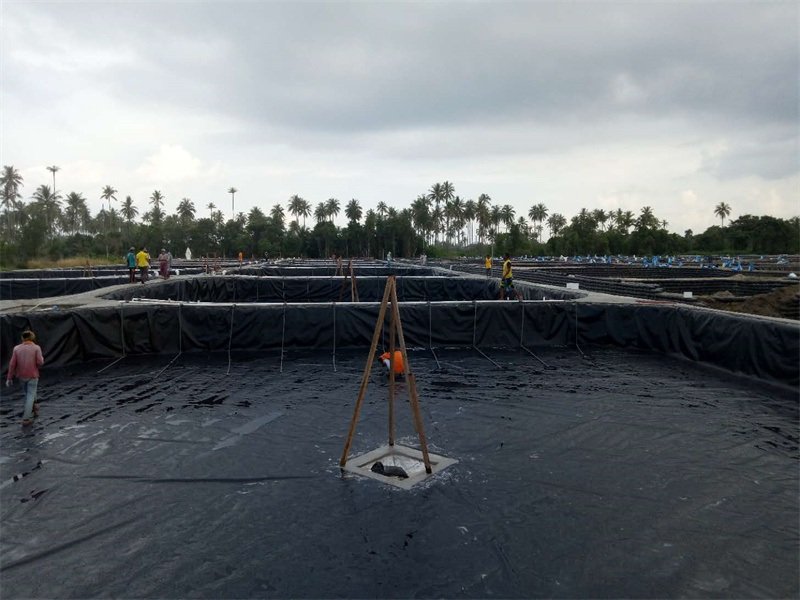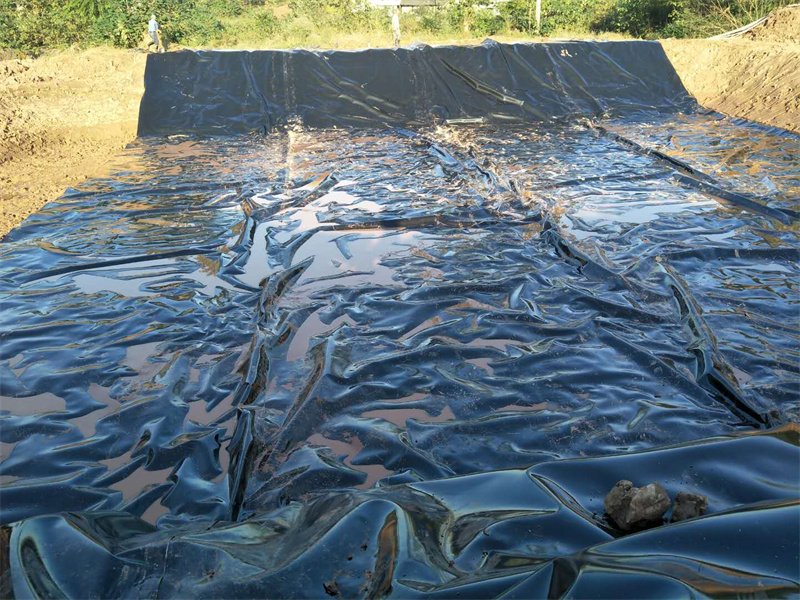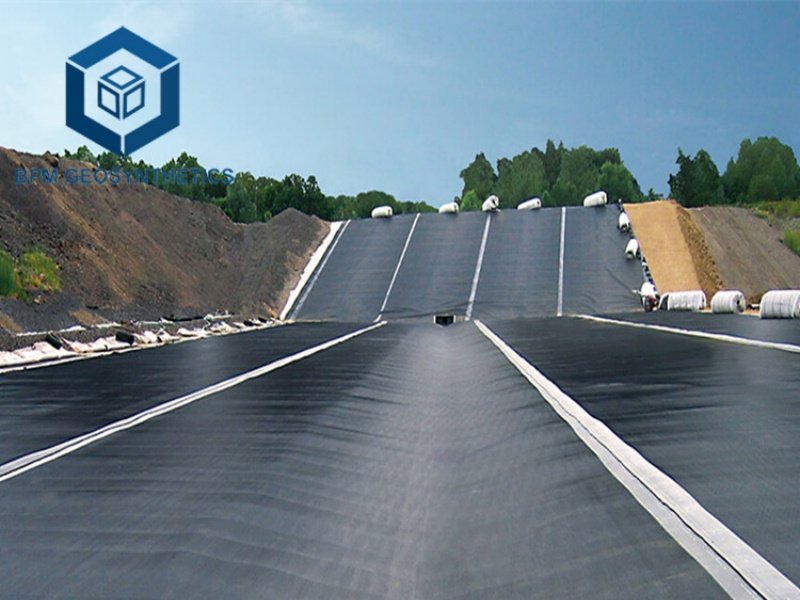1.What is Geomembrana HDPE 40 Mils
Geomembrana HDPE 40 mils also HDPE Geomembrane, is a high-density polyethylene liner engineered to provide exceptional impermeability and long-term durability in the most demanding containment projects. With a precisely controlled thickness of 40 mils—equal to 1.0 mm—this is strikes an optimal balance between flexibility and mechanical strength. Its molecular structure is stabilized with premium UV-resistant additives, ensuring that the geomembrana hdpe 40 mils retains its integrity even after decades of exposure to ultraviolet radiation, thermal cycling, and chemical attack.
1.1 This specific thickness
It is often considered a robust standard for many demanding applications, offering an excellent balance between material performance, ease of installation, and cost-effectiveness. A high-quality geomembrane HDPE 40 mils from a trusted brand like BPM Geosynthetics is engineered with specialized carbon black, antioxidants, and stabilizers to enhance its resistance to ultraviolet (UV) radiation, extreme temperatures, and aggressive chemical exposure, ensuring a long service life even in harsh environments.
Geomembrana hdpe 40 mils is produced from 100 % virgin HDPE resin with a density of 0.940–0.965 g/cm³, blended with 2–3 % carbon black, primary antioxidants and UV stabilizers. BPM Geosynthetics extrudes the molten compound through a flat-die line, then calenders it to an exact 40 mil (1.0 mm) thickness with a ±3 % tolerance. The result is HDPE geomembrane 40 mils that retains mechanical properties for 50 years under normal service temperatures of –50 °C to +80 °C
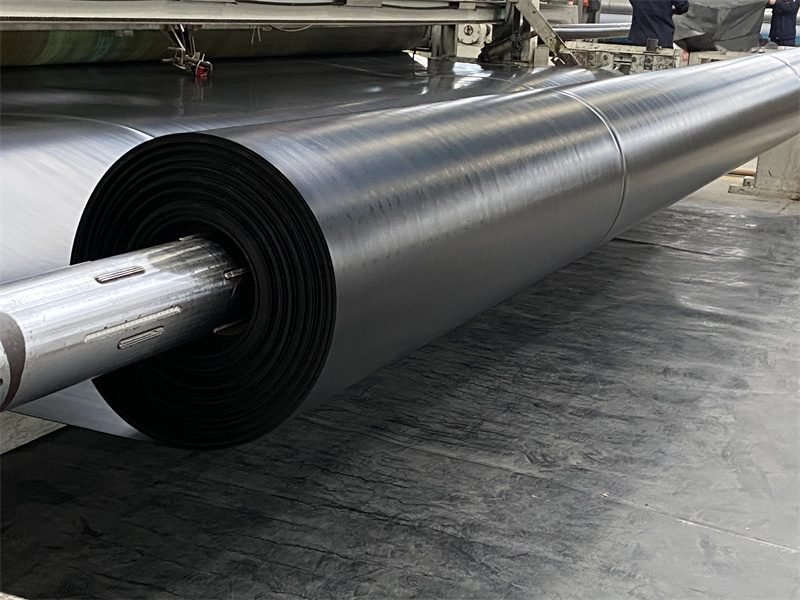
2. Geomembrane HDPE 40 Mil Features
The properties that make a geomembrana HDPE 40 mils so valuable are multifaceted. Its primary characteristic is extremely low permeability, creating an impervious barrier that effectively prevents the migration of liquids or vapors. HDPE is renowned for its exceptional chemical resistance, making it inert to a wide range of corrosive chemicals, acids, alkalis, and solvents, a critical feature in industrial containment. Furthermore, the inherent toughness of the geomembrana HDPE 40 mils provides high puncture and tear resistance, which is crucial when installed over potentially uneven subgrades or when supporting heavy loads. The UV resistance engineered into products like those from BPM Geosynthetics ensures that the material does not become brittle or degrade when exposed to direct sunlight for extended periods, a common challenge in large, exposed containment areas. This combination of properties makes the 40-mil thickness a versatile and dependable choice.
2.1 The popularity of geomembrana hdpe 40 mils stems from its superior performance profile:
Tensile strength ≥ 27 MPa, puncture resistance ≥ 500 N, and a hydraulic conductivity < 1 × 10⁻¹³ cm/s. Carbon-black dispersion gives geomembrana hdpe 40 mils ≥ 90 % strength retention after 1 600 h Q-UV exposure, while stress-crack resistance exceeds 500 h per ASTM D5397. BPM Geosynthetics subjects every batch of geomembrana hdpe 40 mils to third-party verification by Intertek or SGS before shipmen
Its most critical feature is its extremely low permeability, creating an impervious barrier that effectively contains liquids and vapors, preventing seepage and environmental contamination. Secondly, HDPE boasts outstanding chemical resistance, making it inert to a wide range of corrosive chemicals, acids, alkalis, and solvents found in industrial waste, leachate, and mining tailings. The inherent toughness of a 40-mil thickness provides high puncture and tear resistance, which is crucial when installed over potentially uneven subgrades. Furthermore, the UV stabilization in a quality
ensures that the material does not degrade, become brittle, or lose its mechanical properties when exposed to prolonged sunlight, guaranteeing a service life that can exceed decades.
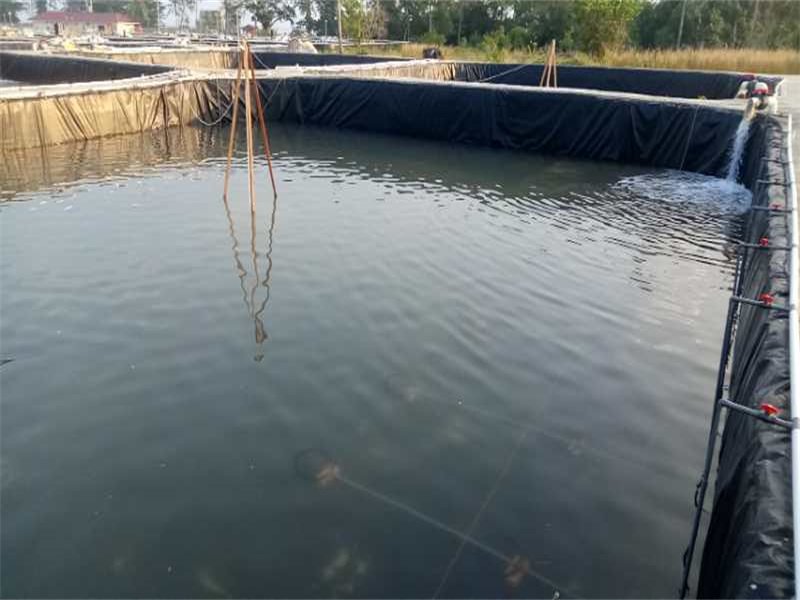
3.Diverse Applications and Uses of Geomembrana HDPE 40 Mil
The versatility of the geomembrana HDPE 40 mils allows it to be deployed in a multitude of sectors. In environmental protection, it is the primary liner material for municipal solid waste landfills and hazardous waste containment cells. It acts as a barrier to prevent leachate from contaminating groundwater and is also used as a cap to close landfills. In water conservation, it is the preferred lining for potable water reservoirs, irrigation canals, and decorative ponds because it is inert and does not leach harmful substances. The mining industry relies heavily on a geomembrana to line tailings dams, heap leach pads, and evaporation ponds, containing harmful chemicals and protecting the local ecosystem. Other applications include secondary containment around fuel tanks, aquaculture pond liners, and as a vapor barrier in construction projects.
3.1 In landfill Basal Liner Systems
Geomembrana hdpe 40 mils functions as the primary hydraulic barrier that prevents leachate from migrating into surrounding soils and groundwater. Typically installed over a prepared subgrade and beneath a geocomposite drainage layer, geomembrana hdpe 40 mils is heat-welded by certified technicians whose seams are then air-pressure tested to verify continuity. Because the 40-mil thickness offers superior elongation at break compared to thinner gauges, geomembrana hdpe 40 mils can tolerate minor differential settlement without compromising its seal. Regulatory agencies such as the U.S. EPA and the EU Landfill Directive recognize , as a technically equivalent alternative to thicker 60-mil liners in many non-hazardous waste applications, enabling project owners to reduce material costs while still meeting stringent environmental compliance standards.
3.2 Mining Systems
Mining operations rely on geomembrana hdpe 40 mils to line tailings impoundments, heap-leach pads, and solution ponds where aggressive chemical solutions and extreme pH levels are commonplace. The outstanding chemical resistance of geomembrana hdpe 40 mils to acids, bases, and metal-cyanide complexes ensures that process fluids remain contained, protecting nearby ecosystems and simplifying water treatment. In Chile, Peru, and other major copper-producing regions, geomembrana hdpe 40 mils is routinely specified for heap-leach projects that exceed 100 hectares in footprint. Its textured surface variants—both structured and co-extruded—enhance interface shear strength, allowing steeper side-slope designs that maximize ore volume within a given footprint. Life-cycle cost analyses demonstrate that geomembranE hdpe reduces both installation time and maintenance expenditures compared to traditional compacted clay liners, yielding a favorable return on investment for mining companies operating under tight environmental regulations.
3.3 Water Systems
Water resource managers deploy geomembrana hdpe 40 mils in potable and irrigation reservoirs to eliminate seepage losses and maintain water quality. The smooth surface of geomembrana hdpe 40 mils minimizes frictional resistance during installation, enabling crews to deploy large panels quickly with minimal wrinkles. Once anchored and ballasted, geomembrana hdpe 40 mils forms a continuous barrier that outperforms concrete, asphalt, or compacted clay by orders of magnitude in hydraulic conductivity—often achieving values lower than 1 × 10⁻¹³ cm/s. In regions where water scarcity drives conservation efforts, geomembrane has been credited with reducing annual evaporation and seepage losses by up to 95 %. Additionally, the NSF-61 certification available for certain grades of geomembrana hdpe 40 mils allows its safe use in direct contact with drinking water, thereby expanding its applicability to municipal tanks and emergency storage reservoirs.
4.Agricultural Systems
Agricultural producers increasingly adopt geomembrana hdpe 40 mils for anaerobic digesters, manure lagoons, and irrigation canals, recognizing its dual benefits of environmental protection and biogas capture. When used as a floating cover on dairy lagoons, geomembrana hdpe 40 mils traps methane emissions that can be harvested for renewable energy, while simultaneously preventing odor release and rainfall infiltration. The 40-mil thickness offers the puncture resistance necessary to withstand mechanical agitation equipment and occasional hoof traffic from livestock. Studies conducted by U.S. universities show that lagoons lined with geomembrana hdpe 40 mils maintain higher and more consistent biogas yields compared to those lined with thinner 30-mil materials, because the added thickness reduces micro-perforations that can compromise gas pressure. Farmers also appreciate that geomembrane requires minimal maintenance—an annual inspection and spot welding of any damaged areas is usually sufficient to ensure continuous performance.
4. Installation Guidelines
Successful performance starts with correct installation of geomembrana hdpe 40 mils. BPM Geosynthetics recommends a smooth, compacted subgrade free of stones > 12 mm, overlain by a 300 gsm non-woven geotextile cushion. Rolls of geomembrana hdpe 40 mils are deployed with 150 mm overlaps and thermally welded using dual-track wedge welders at 400 °C; every seam is air-pressure tested at 30 psi for 5 minutes. Final QA includes vacuum box testing of patches and an electrical leak survey of the entire geomembrana hdpe 40 mils field
5.Pricing & Logistics
BPM Geosynthetics offers geomembrana hdpe 40 mils at factory-direct pricing: approximately USD 1.10–1.35 per m² FOB Qingdao, depending on order volume and surface finish (smooth or textured). A standard 40 HC container loads 20 000 m² of geomembrana hdpe 40 mils (7 m × 100 m rolls), keeping freight below USD 0.15 per m² to most global ports. Letters of credit at sight or 30 % T/T deposits are accepted, and every shipment of geomembrane includes mill certificates, third-party test reports and installation guides.
